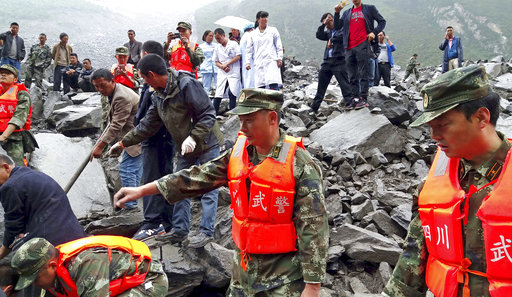
Emergency personnel and local people work at the site of a landslide in Xinmo village in Maoxian County in southwestern China’s Sichuan Province, Saturday, June 24, 2017. (Chinatopix via AP)
BEIJING — Crews searching through the rubble left by a landslide that buried a mountain village under tons of soil and rocks in southwestern China on Saturday found 15 bodies, but more than 110 more people remained missing.
About 3,000 rescuers were using detection devices and dogs to look for signs of life in an area that once held 62 homes and a hotel, Xinhua, the official news agency, reported.
“We won’t give up as long as there is a slim of chance,” the agency quoted an unidentified searcher as saying.
The identities of the 118 missing people in a landslide in southwest China will soon be made public, a government official told Xinhua.
READ: Over 120 people buried by massive southwest China landslide
Xu Zhiwen, executive deputy governor of the Tibetan and Qiang Autonomous Prefecture of Aba, the region where the landslide struck, also said that all 142 tourists who were visiting a site in the mountain village of Xinmo have been found alive.
Three members of one family were located five hours after the landslide. Qiao Dashuai, 26, said he and his wife awoke to cries from their 1-month-old son around 5:30 a.m.
“Just after we changed the diaper for the baby, we heard a big bang outside and the light went out,” said Qiao. “We felt that something bad was happening and immediately rushed to the door, but the door was blocked by mud and rocks.”
Qiao told CCTV his family was swept away by water as part of a mountain collapsed. He said they struggled against the flood of water until they met medical workers who took them to a hospital. His parents and other relatives were among the missing.
The provincial government said more than 120 people were buried by the landslide.
The landslide, which came from a mountain, occurred in the village of Xinmo in Mao County about 6 a.m., the Sichuan provincial government said. Officials said 1.6 kilometers (1 mile) of road were buried in the disaster.
“It’s the biggest landslide to hit this area since the Wenchuan earthquake,” Wang Yongbo, an official leading one of the rescue efforts, told state broadcaster China Central Television. Wang was referring to China’s deadliest earthquake this century, a magnitude 7.9 temblor that struck Sichuan province in May 2008, killing nearly 90,000 people.
Mao County, or Maoxian, sits on the eastern margin of the Tibetan plateau and is home to about 110,000 people, according to the government’s website. Most residents are of the Qiang ethnic minority. The village is known locally for tourism, and Chinese reports said it was unclear if tourists were among those buried by the landslide.
The landslide blocked a 2-kilometer (1.2-mile) section of a river. The provincial government said on its website that an estimated 8 million cubic meters (282 million cubic feet) of earth and rock — equivalent to more than 3,000 Olympic-sized swimming pools — slid down the mountain.
Experts told CCTV that the landslide was likely triggered by rain. A meteorologist interviewed by CCTV said there was light rain in the area that would continue for a few days.
RELATED VIDEO